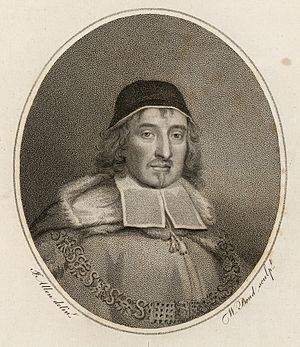John Vaughan (chief justice) facts for kids
Sir John Vaughan (born September 14, 1603 – died December 10, 1674) was an important judge in England. He came from a place called Trawsgoed in Wales. He is remembered for helping to make sure juries could make their own decisions in court.
Contents
Sir John Vaughan's Early Life and Career
Sir John Vaughan was born in Ceredigion, Wales. He was the oldest of eight children. He went to school at The King's School, Worcester and then studied at Christ Church, Oxford. After Oxford, he began studying law at the Inner Temple in London.
In 1625, he married his cousin, Jane Stedman. They had a son named Edward and two daughters, Anne and Lucy.
Becoming a Member of Parliament
In 1628, John Vaughan became a Member of Parliament for Cardigan. This means he was chosen to represent his area in the English government. He served in both the Short and Long Parliaments.
He was a moderate royalist, which means he supported the King but also wanted some changes. For example, he helped create the Triennial Acts. This law made sure Parliament had to meet regularly. However, he refused to support a special law against Thomas Wentworth, saying it was unfair.
Life During the English Civil War
In 1630, John Vaughan became a lawyer. Before the English Civil War started, he moved back to Ceredigion in Wales. He bought a lot of land, about 30,000 acres, which made him one of the richest landowners in the area.
During the Civil War, he was loyal to the King at first. But when the town of Tenby was captured, he became worried. He started training the local army. Because of this, his home was attacked in 1645, and he was not allowed to be in Parliament anymore.
After the war, he stayed out of public life. He mostly lived quietly on his estates.
Return to Public Service
After the King returned to power in England, Sir John Vaughan went back to Parliament in 1661. He represented Cardiganshire. He was offered a job as a judge by his friend, the Earl of Clarendon, who was a chief minister to King Charles II. But Vaughan said no.
Instead, he became a leader of the "country party." This group disagreed with Clarendon. Vaughan was known for being a great speaker. Samuel Pepys, a famous diarist, even called him "the great Vaughan."
Becoming a Chief Justice
In 1668, John Vaughan was made a knight, so he became "Sir John Vaughan." He was also made a "serjeant-at-law," which is a very senior lawyer. A few days later, he became the Chief Justice of the Common Pleas. This was a very important job as a judge.
Bushel's Case: A Landmark Decision
One of his most famous cases was called Bushel's Case in 1670. In this case, a jury refused to change their verdict, even though the judge wanted them to. Sir John Vaughan ruled that a jury could not be forced to change its decision. This was a very important ruling. It means that juries have the freedom to decide cases without a judge telling them what to do. This rule is still used today. There is even a plaque at the Old Bailey court in London that includes his name, along with the names of the jurors from this case.
Sir John Vaughan was also a friend of John Selden, a famous scholar. After Selden died, Vaughan helped manage his estate and made sure Selden's large library went to the Bodleian Library at Oxford University.
Sir John Vaughan died on December 10, 1674. He was buried at Temple Church. His court reports, which were notes from his cases, were published by his son a few years later.




